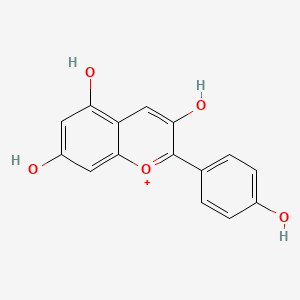| MeSH term | MeSH ID | Detail |
|---|---|---|
| Cystitis | D003556 | 23 associated lipids |
| Parkinsonian Disorders | D020734 | 20 associated lipids |
Pelargonidin
Pelargonidin is a lipid of Polyketides (PK) class. The involved functions are known as Uptake, Intestinal Absorption, glucose uptake, Process and Metabolic Inhibition. Pelargonidin often locates in Serosal, Mucous Membrane, brush border membrane, Membrane and Cell surface. The associated genes with Pelargonidin are SLC5A1 gene, SLC2A2 gene, Homologous Gene, F3 gene and CRSP3 gene. The related experimental models are Knock-out.
Cross Reference
Introduction
To understand associated biological information of Pelargonidin, we collected biological information of abnormalities, associated pathways, cellular/molecular locations, biological functions, related genes/proteins, lipids and common seen animal/experimental models with organized paragraphs from literatures.
What diseases are associated with Pelargonidin?
There are no associated biomedical information in the current reference collection.
Possible diseases from mapped MeSH terms on references
We collected disease MeSH terms mapped to the references associated with Pelargonidin
PubChem Associated disorders and diseases
What pathways are associated with Pelargonidin
There are no associated biomedical information in the current reference collection.
PubChem Biomolecular Interactions and Pathways
Link to PubChem Biomolecular Interactions and PathwaysWhat cellular locations are associated with Pelargonidin?
Visualization in cellular structure
Associated locations are in red color. Not associated locations are in black.
Related references are published most in these journals:
| Location | Cross reference | Weighted score | Related literatures |
|---|
What functions are associated with Pelargonidin?
Related references are published most in these journals:
| Function | Cross reference | Weighted score | Related literatures |
|---|
What lipids are associated with Pelargonidin?
There are no associated biomedical information in the current reference collection.
What genes are associated with Pelargonidin?
Related references are published most in these journals:
| Gene | Cross reference | Weighted score | Related literatures |
|---|
What common seen animal models are associated with Pelargonidin?
Knock-out
Knock-out are used in the study 'MATE2 mediates vacuolar sequestration of flavonoid glycosides and glycoside malonates in Medicago truncatula.' (Zhao J et al., 2011).
Related references are published most in these journals:
| Model | Cross reference | Weighted score | Related literatures |
|---|
NCBI Entrez Crosslinks
All references with Pelargonidin
Download all related citations| Authors | Title | Published | Journal | PubMed Link |
|---|---|---|---|---|
| Nankar AN et al. | Quantitative and qualitative evaluation of kernel anthocyanins from southwestern United States blue corn. | 2016 | J. Sci. Food Agric. | pmid:26879128 |
| Min G et al. | Anti-septic effects of pelargonidin on HMGB1-induced responses in vitro and in vivo. | 2016 | Arch. Pharm. Res. | pmid:27778275 |
| Sohanaki H et al. | Pelargonidin improves memory deficit in amyloid β25-35 rat model of Alzheimer's disease by inhibition of glial activation, cholinesterase, and oxidative stress. | 2016 | Biomed. Pharmacother. | pmid:27470554 |
| Müller-Maatsch J et al. | Co-pigmentation of pelargonidin derivatives in strawberry and red radish model solutions by the addition of phenolic fractions from mango peels. | 2016 | Food Chem | pmid:27451227 |
| Arroyo-Maya IJ et al. | Characterization of flavonoid-protein interactions using fluorescence spectroscopy: Binding of pelargonidin to dairy proteins. | 2016 | Food Chem | pmid:27451201 |
| Kang H et al. | Suppressive Effects of Pelargonidin on Endothelial Protein C Receptor Shedding via the Inhibition of TACE Activity and MAP Kinases. | 2016 | Am. J. Chin. Med. | pmid:27222063 |
| Dhivya S et al. | Impact of Anthocyanidins on Mitoxantrone-Induced Cytotoxicity and Genotoxicity: An In Vitro and In Vivo Analysis. | 2016 | Integr Cancer Ther | pmid:27146128 |
| Samadder A et al. | Nanopharmaceutical approach using pelargonidin towards enhancement of efficacy for prevention of alloxan-induced DNA damage in L6 cells via activation of PARP and p53. | 2016 | Environ. Toxicol. Pharmacol. | pmid:26943895 |
| Warskulat AC et al. | Unprecedented Utilization of Pelargonidin and Indole for the Biosynthesis of Plant Indole Alkaloids. | 2016 | Chembiochem | pmid:26670055 |
| Lai YS et al. | The Dark-Purple Tea Cultivar 'Ziyan' Accumulates a Large Amount of Delphinidin-Related Anthocyanins. | 2016 | J. Agric. Food Chem. | pmid:26996195 |
